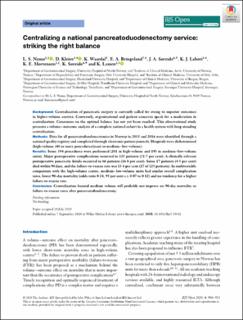| dc.contributor.author | Nymo, Linn Såve | |
| dc.contributor.author | Kleive, Dyre | |
| dc.contributor.author | Waardal, Kim | |
| dc.contributor.author | Bringeland, Erling Audun | |
| dc.contributor.author | Søreide, Jon Arne | |
| dc.contributor.author | Labori, Knut Jørgen | |
| dc.contributor.author | Mortensen, Kim Erlend | |
| dc.contributor.author | Søreide, Kjetil | |
| dc.contributor.author | Lassen, Kristoffer | |
| dc.date.accessioned | 2021-01-29T10:59:21Z | |
| dc.date.available | 2021-01-29T10:59:21Z | |
| dc.date.created | 2020-11-29T13:53:38Z | |
| dc.date.issued | 2020 | |
| dc.identifier.citation | BJS Open. 2020, 4 (5), 904-913. | en_US |
| dc.identifier.issn | 2474-9842 | |
| dc.identifier.uri | https://hdl.handle.net/11250/2725330 | |
| dc.description.abstract | Background
Centralization of pancreatic surgery is currently called for owing to superior outcomes in higher‐volume centres. Conversely, organizational and patient concerns speak for a moderation in centralization. Consensus on the optimal balance has not yet been reached. This observational study presents a volume–outcome analysis of a complete national cohort in a health system with long‐standing centralization.
Methods
Data for all pancreatoduodenectomies in Norway in 2015 and 2016 were identified through a national quality registry and completed through electronic patient journals. Hospitals were dichotomized (high‐volume (40 or more procedures/year) or medium–low‐volume).
Results
Some 394 procedures were performed (201 in high‐volume and 193 in medium–low‐volume units). Major postoperative complications occurred in 125 patients (31·7 per cent). A clinically relevant postoperative pancreatic fistula occurred in 66 patients (16·8 per cent). Some 17 patients (4·3 per cent) died within 90 days, and the failure‐to‐rescue rate was 13·6 per cent (17 of 125 patients). In multivariable comparison with the high‐volume centre, medium–low‐volume units had similar overall complication rates, lower 90‐day mortality (odds ratio 0·24, 95 per cent c.i. 0·07 to 0·82) and no tendency for a higher failure‐to‐rescue rate.
Conclusion
Centralization beyond medium volume will probably not improve on 90‐day mortality or failure‐to‐rescue rates after pancreatoduodenectomy. | en_US |
| dc.language.iso | eng | en_US |
| dc.publisher | British Journal of Surgery Society, Wiley | en_US |
| dc.rights | Navngivelse-Ikkekommersiell 4.0 Internasjonal | * |
| dc.rights.uri | http://creativecommons.org/licenses/by-nc/4.0/deed.no | * |
| dc.title | Centralizing a national pancreatoduodenectomy service: striking the right balance | en_US |
| dc.type | Peer reviewed | en_US |
| dc.type | Journal article | en_US |
| dc.description.version | publishedVersion | en_US |
| dc.source.pagenumber | 904-913 | en_US |
| dc.source.volume | 4 | en_US |
| dc.source.journal | BJS Open | en_US |
| dc.source.issue | 5 | en_US |
| dc.identifier.doi | 10.1002/bjs5.50342 | |
| dc.identifier.cristin | 1853762 | |
| dc.description.localcode | © 2020 The Authors. BJS Open published by John Wiley & Sons Ltd on behalf of British Journal of Surgery Society. This is an open access article under the terms of the Creative Commons Attribution‐NonCommercial License, which permits use, distribution and reproduction in any medium, provided the original work is properly cited and is not used for commercial purposes. | en_US |
| cristin.ispublished | true | |
| cristin.fulltext | original | |
| cristin.qualitycode | 1 | |

